Using Hybrid Deep Learning Models to Predict Dust Storm Pathways with Enhanced Accuracy
Abstract
1. Introduction
2. Materials and Methods
2.1. Study Region
2.2. Data
2.3. Methodology
2.3.1. CNN
2.3.2. LSTM
2.3.3. CNN-LSTM
2.3.4. ConvLSTM
2.4. Evaluation Metrics
2.5. Random Forest Feature Importance
3. Results
3.1. RFFI Model Output
3.2. CNN-LSTM Model Output
3.3. ConvLSTM Model Output
4. Discussion
4.1. The Effect of Contextual Information on Prediction Accuracy
4.2. Comparison the the Prediction Accuracy of CNN-LSTM and ConvLSTM Models
5. Conclusions
Author Contributions
Funding
Data Availability Statement
Conflicts of Interest
References
- Manisalidis, I.; Stavropoulou, E.; Stavropoulos, A.; Bezirtzoglou, E. Environmental and health impacts of air pollution: A review. Front. Public Health 2020, 8, 14. [Google Scholar] [CrossRef]
- Wang, W.; Samat, A.; Abuduwaili, J.; Ge, Y.; De Maeyer, P.; Van de Voorde, T. Temporal characterization of sand and dust storm activity and its climatic and terrestrial drivers in the Aral Sea region. Atmos. Res. 2022, 275, 106242. [Google Scholar] [CrossRef]
- Han, X.; Liu, L.; Shi, P.; Zhang, G.; Liu, Y.; Zhang, X.; Yang, Y.; Qu, Z.; Wang, G.; Hu, Z.; et al. Dust Storm and Haze Convergence Process and its Effect on Air Pollution in Northern China. SSRN Electron. J. 2022. [Google Scholar] [CrossRef]
- Miri, A.; Middleton, N. Long-term impacts of dust storms on transport systems in south-eastern Iran. Nat. Hazards 2022, 114, 291–312. [Google Scholar] [CrossRef]
- Miri, A.; Shirmohammadi, E.; Sorooshian, A. Impacts of dust storms on indoor and outdoor bioaerosol concentration in the Sistan region of Iran. J. Build. Eng. 2023, 76, 107302. [Google Scholar] [CrossRef]
- Zheng, C.; Li, Z.-q.; Zhou, P.; Zhang, X.; Zhou, X.; Ma, S. Physicochemical Impacts of Dust Storms on Aerosol and Glacier Meltwater on the Northern Margin of the Taklimakan Desert. Front. Earth Sci. 2021, 8, 527663. [Google Scholar] [CrossRef]
- Liang, L.; Han, Z.; Li, J.; Xia, X.; Sun, Y.; Liao, H.; Liu, R.; Liang, M.; Gao, Y.; Zhang, R. Emission, transport, deposition, chemical and radiative impacts of mineral dust during severe dust storm periods in March 2021 over East Asia. Sci. Total Environ. 2022, 852, 158459. [Google Scholar] [CrossRef] [PubMed]
- Khennou, F.; Ghaoui, J.; Akhloufi, M.A. Forest fire spread prediction using deep learning. In Geospatial Informatics XI; SPIE: Bellingham, WA, USA, 2021. [Google Scholar]
- Wang, R.; Zhu, Z.; Zhu, W.; Fu, X.; Xing, S. A dynamic marine oil spill prediction model based on deep learning. J. Coast. Res. 2021, 37, 716–725. [Google Scholar] [CrossRef]
- Draxler, R.R.; Hess, G. An overview of the HYSPLIT_4 modelling system for trajectories. Aust. Meteorol. Mag. 1998, 47, 295–308. [Google Scholar]
- Khalidy, R.; Salmabadi, H.; Saeedi, M. Numerical simulation of a severe dust storm over Ahvaz using the HYSPLIT model. Int. J. Environ. Res. 2019, 13, 161–174. [Google Scholar] [CrossRef]
- Stein, A.F.; Draxler, R.R.; Rolph, G.D.; Stunder, B.J.; Cohen, M.D.; Ngan, F. NOAA’s HYSPLIT atmospheric transport and dispersion modeling system. Bull. Am. Meteorol. Soc. 2015, 96, 2059–2077. [Google Scholar] [CrossRef]
- Li, T.; Ren, Q.-d.-e.-j.; Qiu, Y. Application of improved naive bayesian-CNN classification algorithm in sandstorm prediction in inner mongolia. Adv. Meteorol. 2019, 2019, 5176576. [Google Scholar]
- Li, N.; Zhang, W. Research on sand-dust storm forecasting based on deep neural network with stacking ensemble learning. IEEE Access 2022, 10, 111855–111863. [Google Scholar]
- Yarmohamadi, M.; Alesheikh, A.A.; Sharif, M.; Vahidi, H. Predicting dust-storm transport pathways using a convolutional neural network and geographic context for impact adaptation and mitigation in urban areas. Remote Sens. 2023, 15, 2468. [Google Scholar] [CrossRef]
- Sadaria, D.P.; Khachariya, D.H.; Hirpara, D.J. Exploring the Diverse Applications of Deep Learning Across Multiple Domains. rrrj 2023, 2, 183–200. [Google Scholar] [CrossRef]
- Farmanifard, S.; Alesheikh, A.A.; Sharif, M. A context-aware hybrid deep learning model for the prediction of tropical cyclone trajectories. Expert Syst. Appl. 2023, 231, 120701. [Google Scholar] [CrossRef]
- Sharif, M.; Alesheikh, A.A. Context-aware movement analytics: Implications, taxonomy, and design framework. Wiley Interdiscip. Rev. Data Min. Knowl. Discov. 2018, 8, e1233. [Google Scholar] [CrossRef]
- Sharif, M.; Alesheikh, A.A.; Tashayo, B. CaFIRST: A context-aware hybrid fuzzy inference system for the similarity measure of multivariate trajectories. J. Intell. Fuzzy Syst. 2019, 36, 5383–5395. [Google Scholar] [CrossRef]
- Sarafian, R.; Nissenbaum, D.; Raveh-Rubin, S.; Agrawal, V.; Rudich, Y. Deep multi-task learning for early warnings of dust events implemented for the Middle East. Npj Clim. Atmos. Sci. 2023, 6, 23. [Google Scholar] [CrossRef]
- Csavina, J.; Field, J.; Taylor, M.P.; Gao, S.; Landázuri, A.; Betterton, E.A.; Sáez, A.E. A review on the importance of metals and metalloids in atmospheric dust and aerosol from mining operations. Sci. Total Environ. 2012, 433, 58–73. [Google Scholar] [CrossRef] [PubMed]
- Khusfi, Z.E.; Khosroshahi, M.; Roustaei, F.; Mirakbari, M. Spatial and seasonal variations of sand-dust events and their relation to atmospheric conditions and vegetation cover in semi-arid regions of central Iran. Geoderma 2020, 365, 114225. [Google Scholar] [CrossRef]
- Rashki, A.; Kaskaoutis, D.; Goudie, A.S.; Kahn, R. Dryness of ephemeral lakes and consequences for dust activity: The case of the Hamoun drainage basin, southeastern Iran. Sci. Total Environ. 2013, 463, 552–564. [Google Scholar] [CrossRef]
- Soleimani, Z.; Teymouri, P.; Boloorani, A.D.; Mesdaghinia, A.; Middleton, N.; Griffin, D.W. An overview of bioaerosol load and health impacts associated with dust storms: A focus on the Middle East. Atmos. Environ. 2020, 223, 117187. [Google Scholar] [CrossRef]
- Khashi, K.; Azhdary Moghaddam, M.; Hashemi Monfared, S. Effects of wetlands and wind velocity on dust propagation in arid areas: A critical case study in south-east of Iran. Int. J. Environ. Sci. Technol. 2022, 19, 12169–12180. [Google Scholar] [CrossRef]
- Cao, H.; Liu, J.; Wang, G.; Yang, G.; Luo, L. Identification of sand and dust storm source areas in Iran. J. Arid Land 2015, 7, 567–578. [Google Scholar] [CrossRef]
- Wang, R.; Liu, B.; Li, H.; Zou, X.; Wang, J.; Liu, W.; Cheng, H.; Kang, L.; Zhang, C. Variation of strong dust storm events in Northern China during 1978–2007. Atmos. Res. 2017, 183, 166–172. [Google Scholar] [CrossRef]
- Samman, A.E.; Butt, M.J. Aerosol Types and Their Climatology over the Dust Belt Region. Atmosphere 2023, 14, 1610. [Google Scholar] [CrossRef]
- Shen, H.; Abuduwaili, J.; Samat, A.; Ma, L. A review on the research of modern aeolian dust in Central Asia. Arab. J. Geosci. 2016, 9, 625. [Google Scholar] [CrossRef]
- Francis, D.; Fonseca, R.M.; Nelli, N.R.; Bozkurt, D.N.; Cuesta, J.; Bosc, E. On the Middle East’s severe dust storms in spring 2022: Triggers and impacts. Atmos. Environ. 2022, 296, 119539. [Google Scholar] [CrossRef]
- Eleftheriou, A.; Mouzourides, P.; Biskos, G.; Yiallouros, P.; Kumar, P.; Neophytou, M.K.-A. The challenge of adopting mitigation and adaptation measures for the impacts of sand and dust storms in Eastern Mediterranean Region: A critical review. Mitig. Adapt. Strateg. Glob. Change 2023, 28, 33. [Google Scholar] [CrossRef]
- Indoitu, R.; Orlovsky, L.; Orlovsky, N. Dust storms in Central Asia: Spatial and temporal variations. J. Arid Environ. 2012, 85, 62–70. [Google Scholar] [CrossRef]
- Kaskaoutis, D.G.; Francis, D.; Rashki, A.; Chaboureau, J.-P.; Dumka, U.C. Atmospheric dynamics from synoptic to local scale during an intense frontal dust storm over the Sistan Basin in winter 2019. Geosciences 2019, 9, 453. [Google Scholar] [CrossRef]
- Hussain, A.; Mir, H.; Afzal, M. Analysis of dust storms frequecny over pakistan during 1961–2000. Pak. J. Meteorol. 2005, 2, 49–68. [Google Scholar]
- Randles, C.; Da Silva, A.; Buchard, V.; Colarco, P.; Darmenov, A.; Govindaraju, R.; Smirnov, A.; Holben, B.; Ferrare, R.; Hair, J. The MERRA-2 aerosol reanalysis, 1980 onward. Part I: System description and data assimilation evaluation. J. Clim. 2017, 30, 6823–6850. [Google Scholar] [CrossRef]
- Koster, R.D.; Bosilovich, M.G.; Akella, S.; Lawrence, C.; Cullather, R.; Draper, C.; Gelaro, R.; Kovach, R.; Liu, Q.; Molod, A. Technical Report Series on Global Modeling and Data Assimilation; NASA: Washington, DC, USA, 2015; Volume 43. [Google Scholar]
- Yoon, J.; Yoo, C.; Ha, E. On the use of threshold for the ground validation of satellite rain rate. Adv. Meteorol. 2015, 2015, 254378. [Google Scholar] [CrossRef]
- Boulila, W.; Ghandorh, H.; Khan, M.A.; Ahmed, F.; Ahmad, J. A novel CNN-LSTM-based approach to predict urban expansion. Ecol. Inform. 2021, 64, 101325. [Google Scholar] [CrossRef]
- Fu, Y.; Huang, T.S. Unsupervised locally embedded clustering for automatic high-dimensional data labeling. In Proceedings of the 2007 IEEE International Conference on Acoustics, Speech and Signal Processing-ICASSP’07, Honolulu, HI, USA, 15–20 April 2007; IEEE: New York, NY, USA, 2007. [Google Scholar]
- Otsu, N. A threshold selection method from gray-level histograms. Automatica 1975, 11, 23–27. [Google Scholar] [CrossRef]
- LeCun, Y.; Bottou, L.; Bengio, Y.; Haffner, P. Gradient-based learning applied to document recognition. Proc. IEEE 1998, 86, 2278–2324. [Google Scholar] [CrossRef]
- Xie, G.; Shangguan, A.; Fei, R.; Ji, W.; Ma, W.; Hei, X. Motion trajectory prediction based on a CNN-LSTM sequential model. Sci. China Inf. Sci. 2020, 63, 212207. [Google Scholar] [CrossRef]
- Schmidt, R.M. Recurrent neural networks (rnns): A gentle introduction and overview. arXiv 2019, arXiv:1912.05911. [Google Scholar]
- Hochreiter, S.; Schmidhuber, J. Long short-term memory. Neural Comput. 1997, 9, 1735–1780. [Google Scholar] [CrossRef] [PubMed]
- Yu, Y.; Si, X.; Hu, C.; Zhang, J. A review of recurrent neural networks: LSTM cells and network architectures. Neural Comput. 2019, 31, 1235–1270. [Google Scholar] [CrossRef]
- Yin, M.; Liao, S.; Liu, X.-Y.; Wang, X.; Yuan, B. Compressing recurrent neural networks using hierarchical tucker tensor decomposition. arXiv 2020, arXiv:2005.04366. [Google Scholar]
- Farnaaz, N.; Jabbar, M. Random forest modeling for network intrusion detection system. Procedia Comput. Sci. 2016, 89, 213–217. [Google Scholar] [CrossRef]
- Louppe, G.; Wehenkel, L.; Sutera, A.; Geurts, P. Understanding variable importances in forests of randomized trees. Adv. Neural Inf. Process. Syst. 2013, 26, 431–439. [Google Scholar]
- Scornet, E. Trees, forests, and impurity-based variable importance in regression. In Annales de l’Institut Henri Poincare (B) Probabilites et Statistiques; Institut Henri Poincaré: Paris, France, 2023. [Google Scholar]
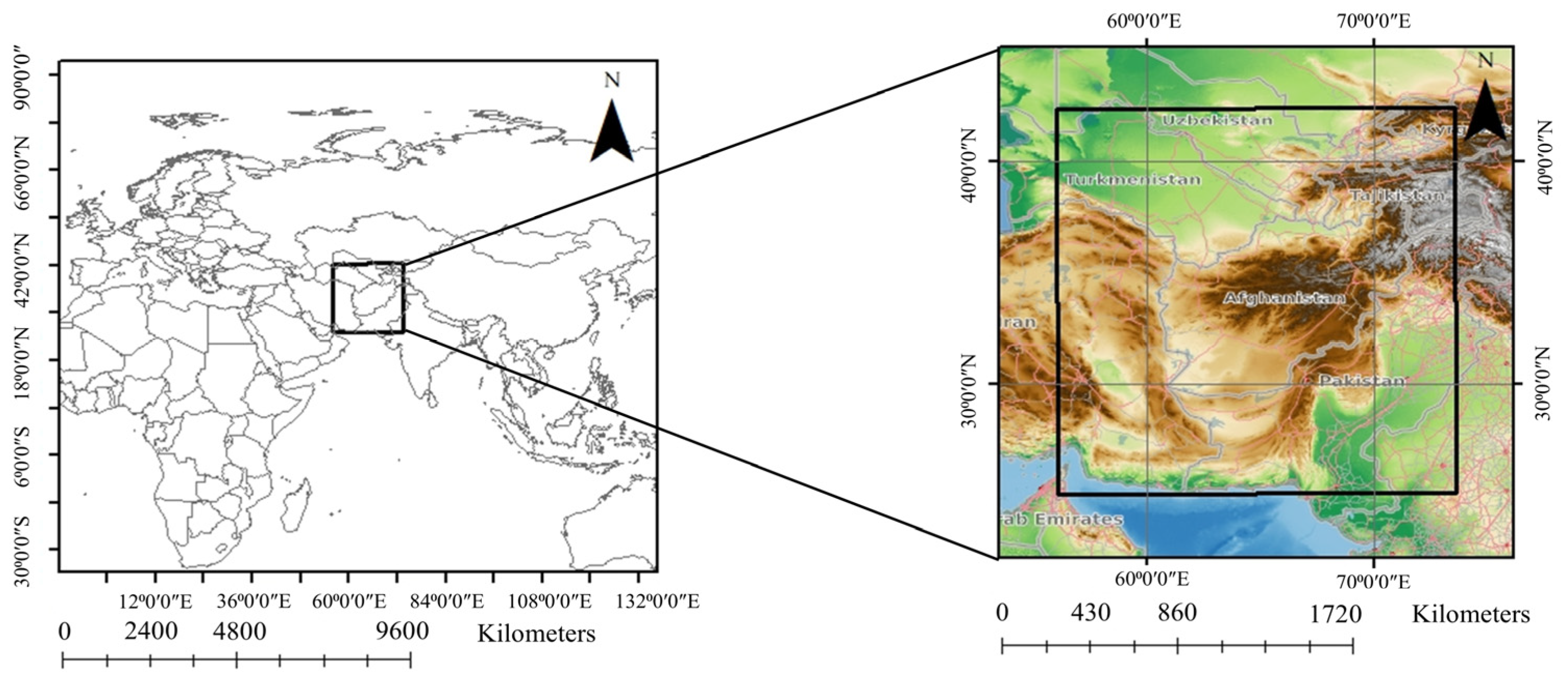

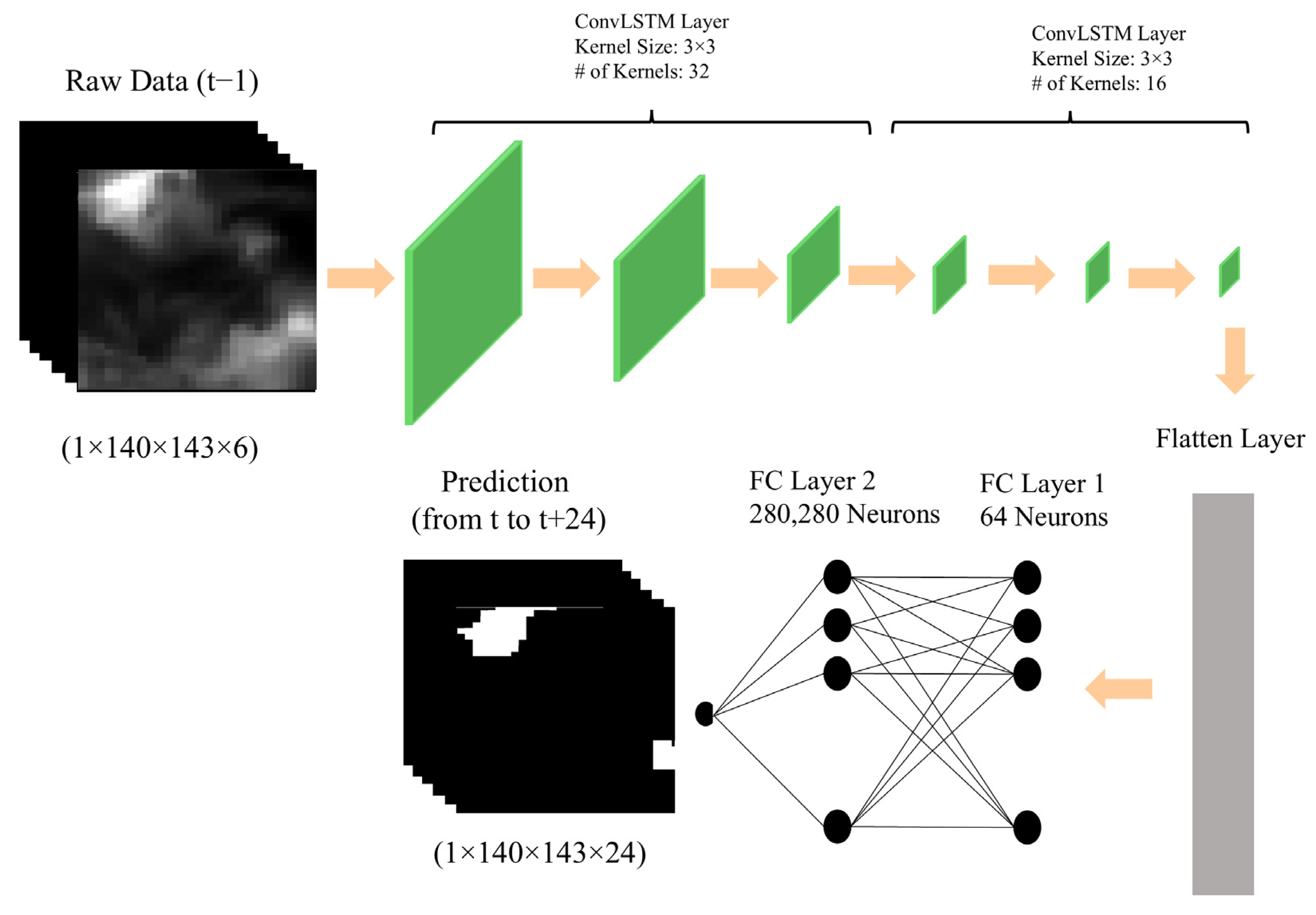
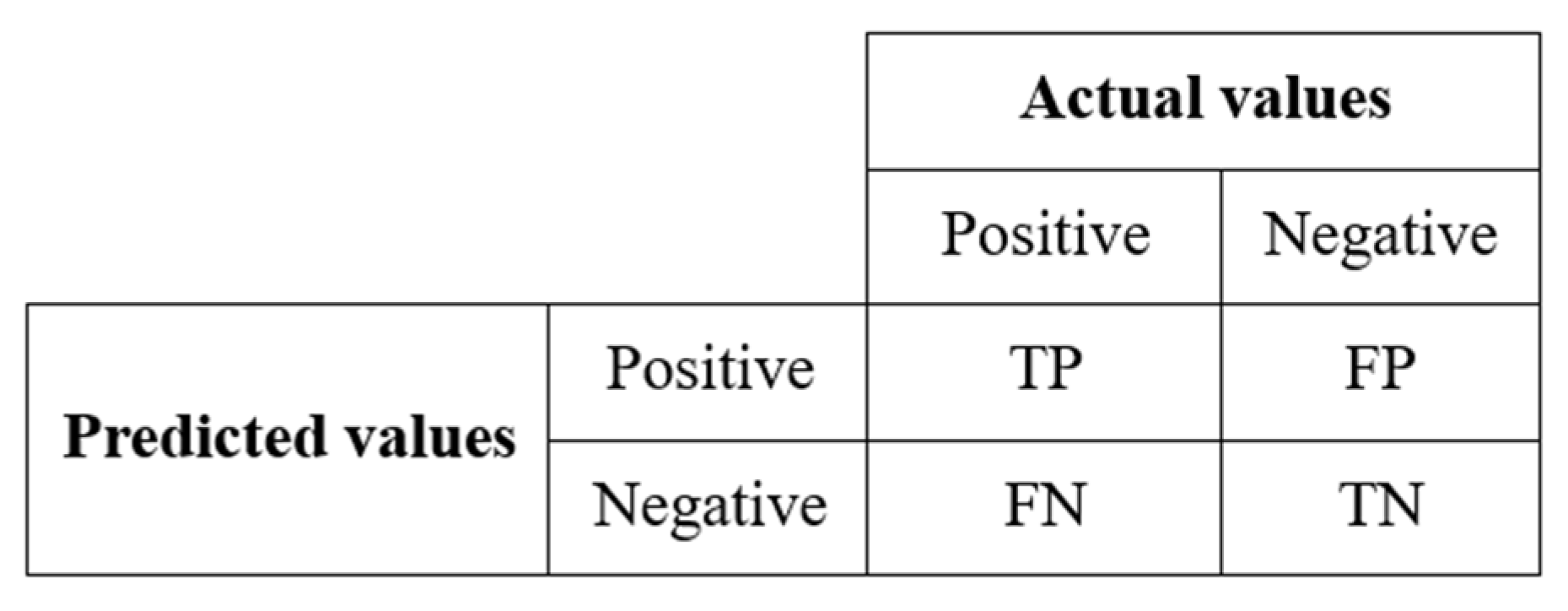
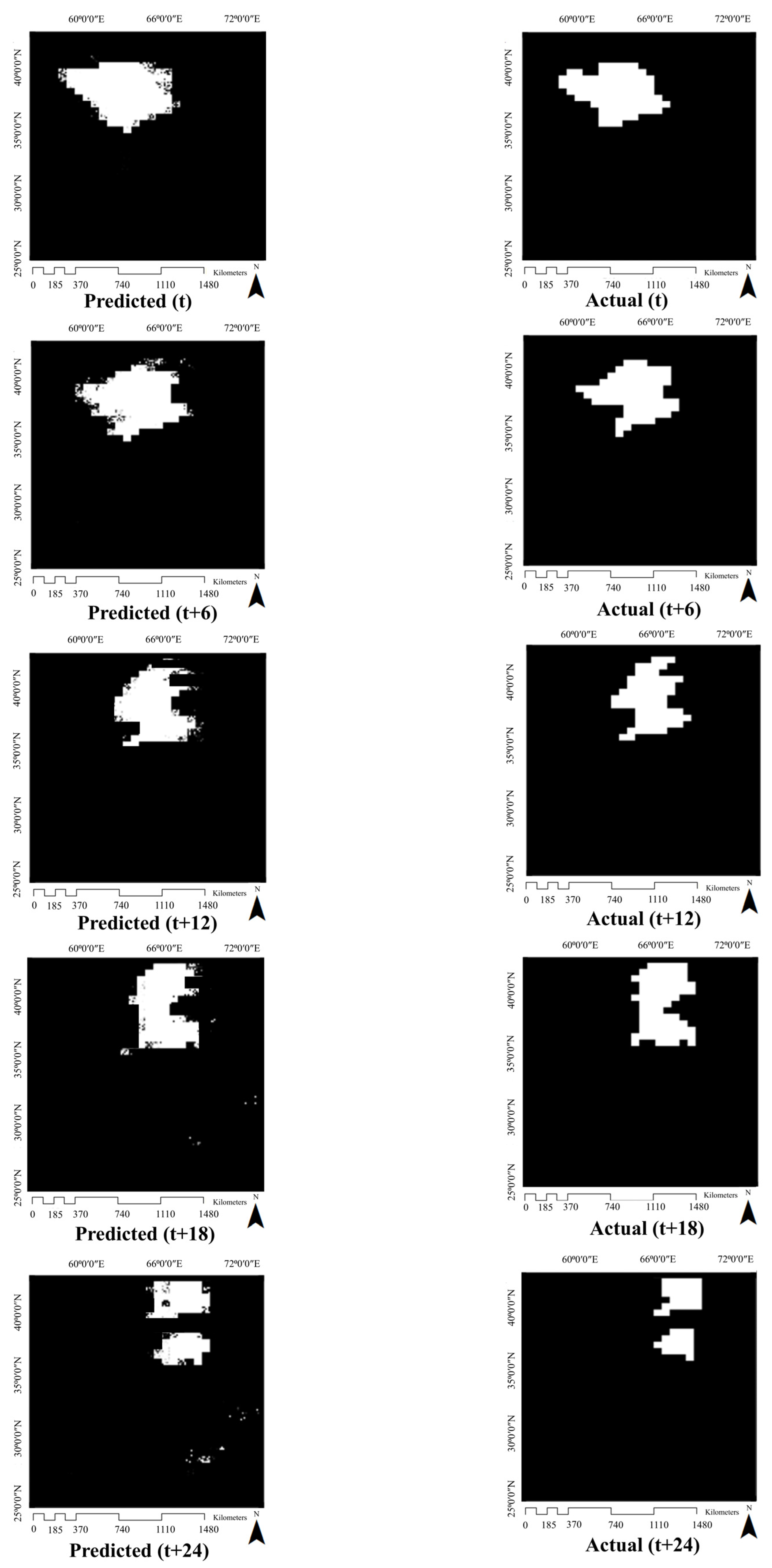
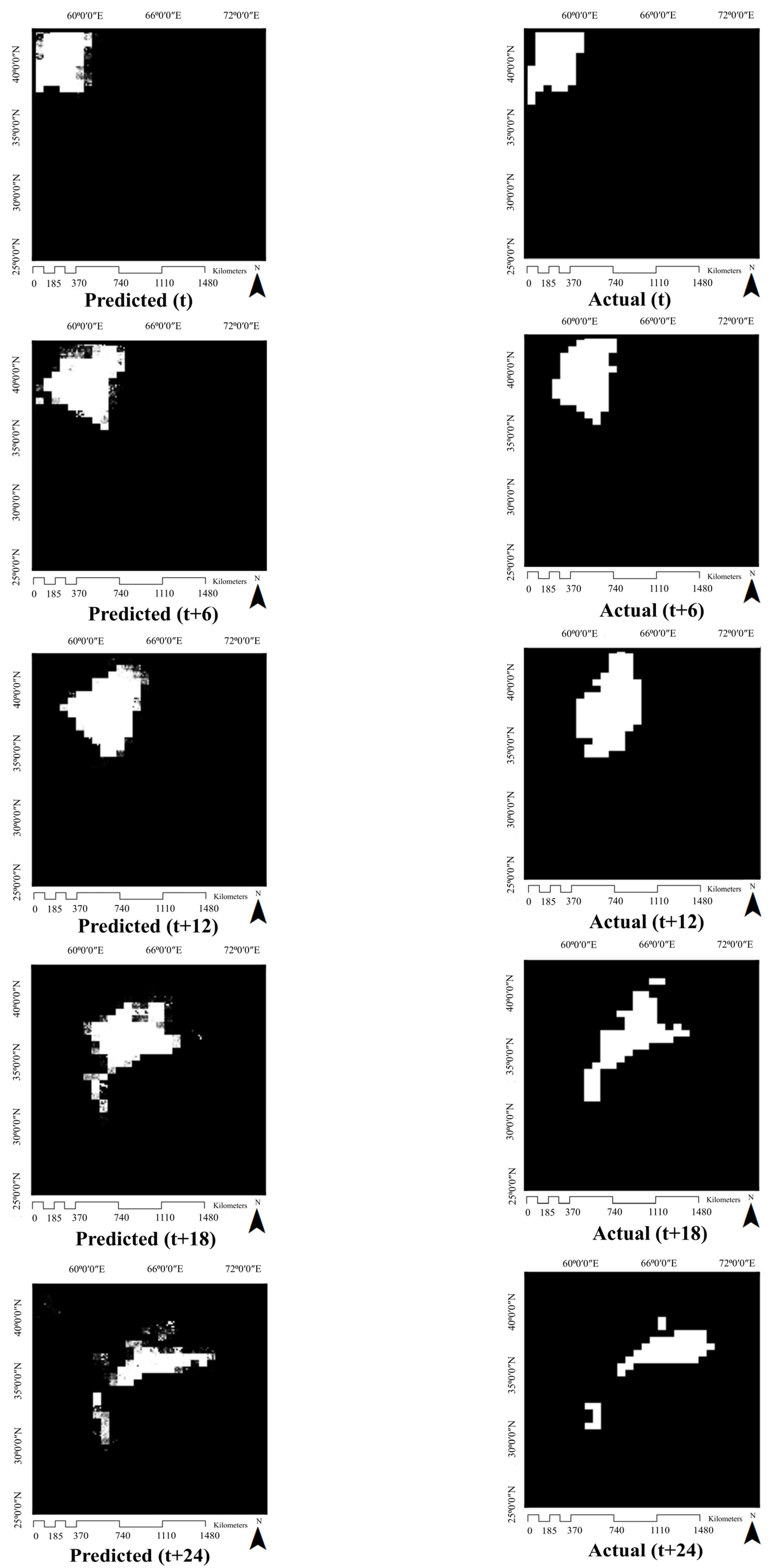
| Prediction Time | Without Contextual Information | With Contextual Information | |||||
|---|---|---|---|---|---|---|---|
| Recall | Precision | Recall | Precision | Overall Accuracy | F1 Score | Kappa Coefficient | |
| t + 6 | 0.7122 | 0.8 | 0.7136 | 0.8160 | 0.9825 | 0.7609 | 0.612 |
| t + 12 | 0.7475 | 0.8552 | 0.7559 | 0.8608 | 0.9852 | 0.8051 | 0.734 |
| t + 18 | 0.7313 | 0.842 | 0.7234 | 0.8688 | 0.9856 | 0.792 | 0.766 |
| t + 24 | 0.7256 | 0.8386 | 0.7242 | 0.8689 | 0.9853 | 0.7939 | 0.769 |
| Prediction Time | Without Contextual Information | With Contextual Information | |||||
|---|---|---|---|---|---|---|---|
| Recall | Precision | Recall | Precision | Overall Accuracy | F1 Score | Kappa Coefficient | |
| t + 6 | 0.684 | 0.826 | 0.759 | 0.8271 | 0.9682 | 0.7919 | 0.5379 |
| t + 12 | 0.7 | 0.831 | 0.752 | 0.8246 | 0.9679 | 0.7871 | 0.5433 |
| t + 18 | 0.685 | 0.851 | 0.7479 | 0.8266 | 0.968 | 0.7852 | 0.5435 |
| t + 24 | 0.641 | 0.853 | 0.739 | 0.8169 | 0.9676 | 0.7756 | 0.5465 |
Disclaimer/Publisher’s Note: The statements, opinions and data contained in all publications are solely those of the individual author(s) and contributor(s) and not of MDPI and/or the editor(s). MDPI and/or the editor(s) disclaim responsibility for any injury to people or property resulting from any ideas, methods, instructions or products referred to in the content. |
© 2025 by the authors. Licensee MDPI, Basel, Switzerland. This article is an open access article distributed under the terms and conditions of the Creative Commons Attribution (CC BY) license (https://creativecommons.org/licenses/by/4.0/).
Share and Cite
Yarmohamadi, M.; Alesheikh, A.A.; Sharif, M. Using Hybrid Deep Learning Models to Predict Dust Storm Pathways with Enhanced Accuracy. Climate 2025, 13, 16. https://doi.org/10.3390/cli13010016
Yarmohamadi M, Alesheikh AA, Sharif M. Using Hybrid Deep Learning Models to Predict Dust Storm Pathways with Enhanced Accuracy. Climate. 2025; 13(1):16. https://doi.org/10.3390/cli13010016
Chicago/Turabian StyleYarmohamadi, Mahdis, Ali Asghar Alesheikh, and Mohammad Sharif. 2025. "Using Hybrid Deep Learning Models to Predict Dust Storm Pathways with Enhanced Accuracy" Climate 13, no. 1: 16. https://doi.org/10.3390/cli13010016
APA StyleYarmohamadi, M., Alesheikh, A. A., & Sharif, M. (2025). Using Hybrid Deep Learning Models to Predict Dust Storm Pathways with Enhanced Accuracy. Climate, 13(1), 16. https://doi.org/10.3390/cli13010016






